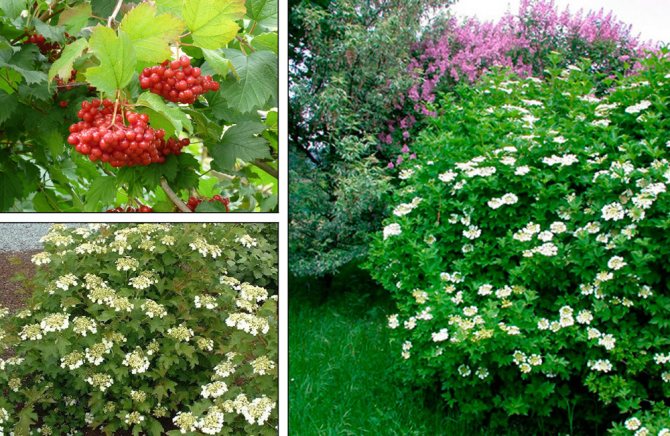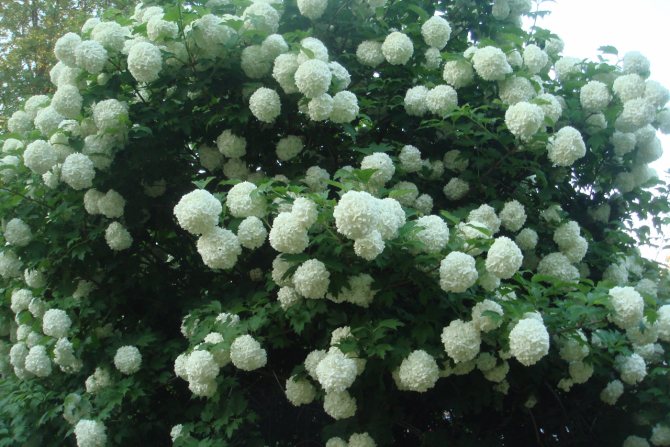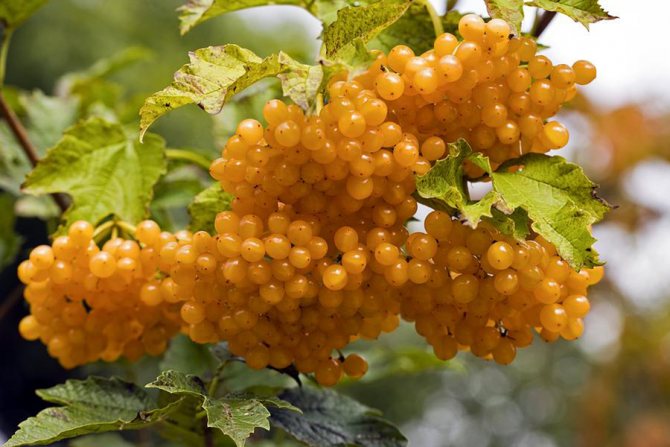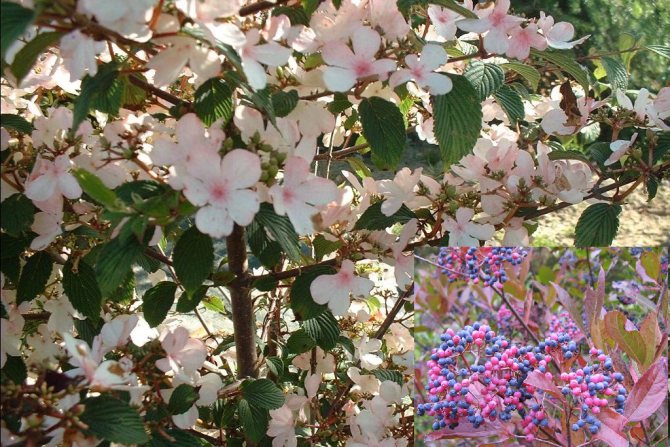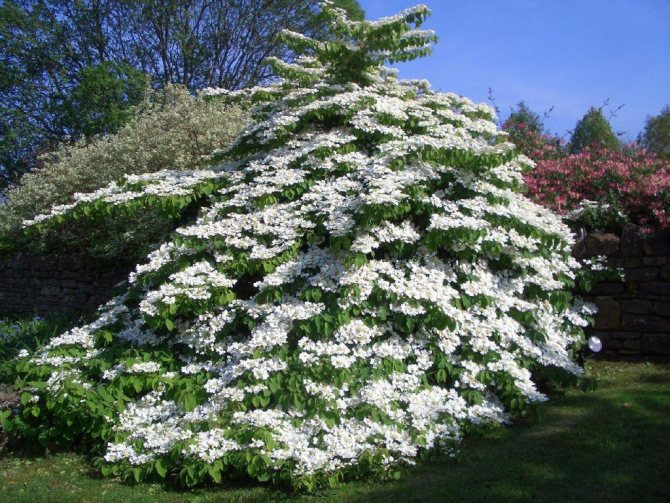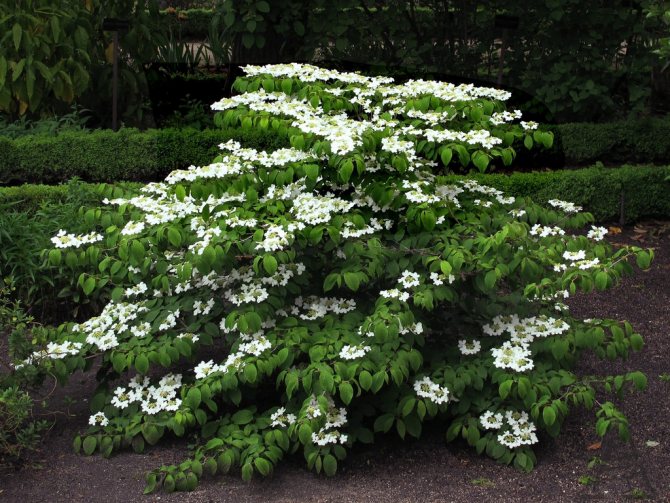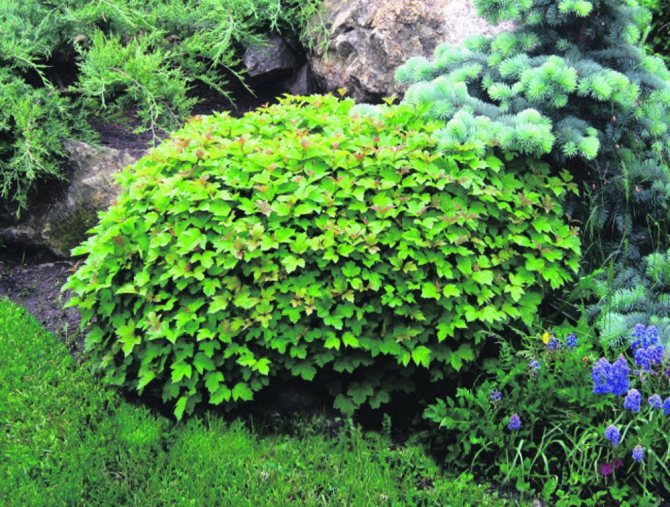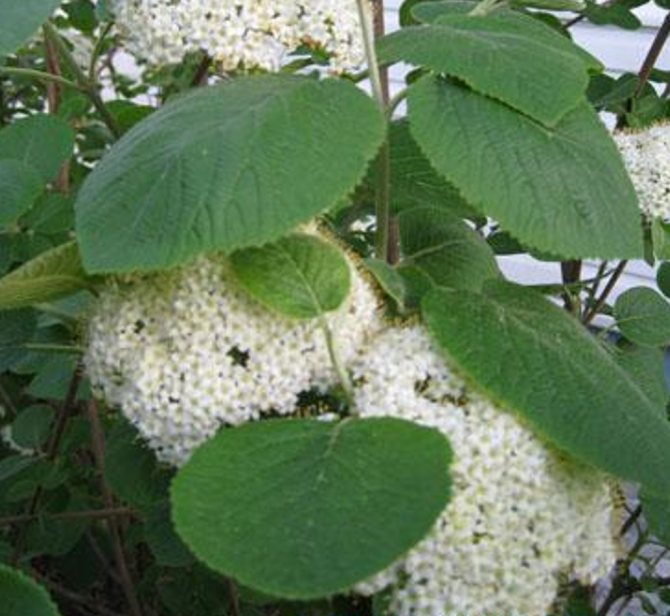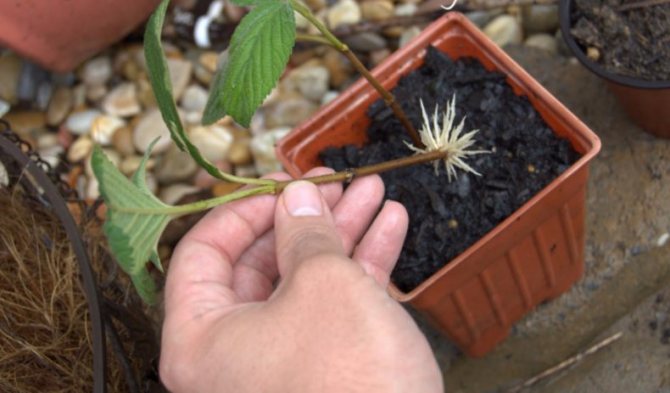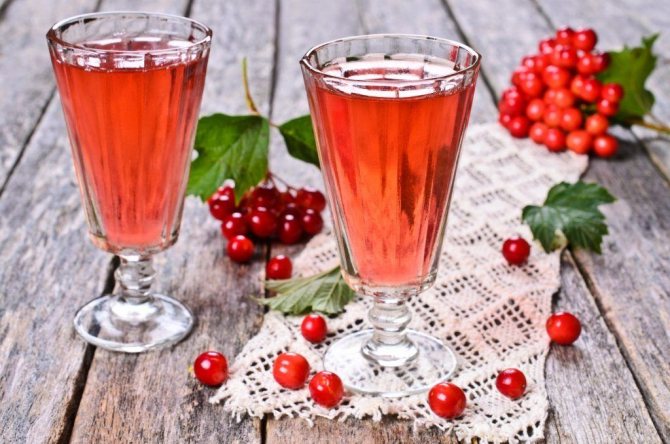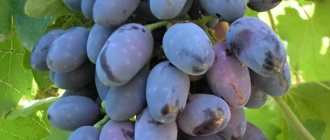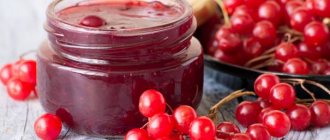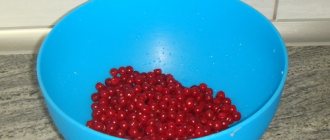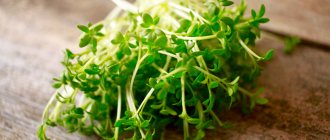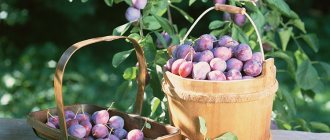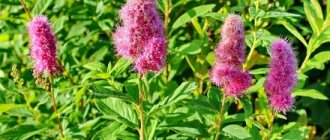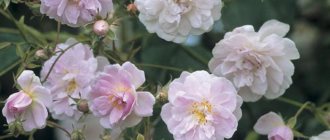In folk medicine, the healing properties of viburnum are well known. Its berries, bark and roots have been used as a folk remedy for many diseases for centuries, but it has never been considered an ornamental plant. And only at the beginning of the last century, breeders paid attention to the luxurious inflorescences and dense carved foliage of the plant. Today, gardeners are actively incorporating shrubs into landscaping. Any sort of viburnum adorns the garden throughout the season - at the beginning of summer - with luxurious flowering, towards the end - with clusters of ruby and black berries, in autumn - with crimson foliage.
- The most decorative varieties with names and photos
Viburnum ordinary
"Buldenezh"
- "Roseum"
- "Compactum"
- Dwarf "Nanum"
- "Xanthocarpum"
- "Watanabe"
- "Renaissance"
The best varieties of viburnum
If you decide to grow viburnum as a fruit plant, then it is better to buy varietal. By means of selection, our scientists have developed high-yielding varieties with a slight bitterness of fruit and a high content of nutrients, frost-resistant and fruiting annually.
Vigorovskaya. The bush is up to 3 m high. Fruits are bright red, spherical, weighing 0.5 g. Bitter-sour taste, slightly bitter after processing. Productivity up to 10 kg per bush.
Garnet bracelet . Bush up to 3 m high, spreading. Fruits are maroon, oval, weighing up to 1 g. The taste is pleasant, slightly bitter. Productivity is about 15 kg per bush.
Zholobovskaya. The bush is up to 2.5 m high. Fruits are dark red, oval, weighing up to 0.8 g. The taste is sweet and sour with a slight bitterness. Productivity up to 7 kg per bush.
Sunset. The bush is up to 4 m high, vigorous. The fruits are bright scarlet, round, weighing up to 0.7 g. The taste is sweet and sour, with a noticeable bitterness. Productivity up to 10 kg per bush.
Zarnitsa. Shrub up to 3 m high. Fruits are light red, oval, weighing up to 0.6 g. Bitter-sour taste, slightly bitter in processed products. Productivity up to 10 kg per bush. The autumn color of the leaves is crimson and golden.
Red bunch. The bush is up to 3 m high, the shoots are straight. The fruits are bright red, round, weighing up to 0.7 g. The taste is sweet and sour, with a slight bitterness. Productivity is about 10 kg per bush.
Maria. The bush is densely branched, more than 3 m high, with thick shoots. Fruits are collected compactly, weighing up to 0.6 g. Sweetish-sour taste, with light astringency. Productivity up to 13 kg per bush.
Ryabinushka. The bush is up to 4 m high, the shoots are straight. Fruits are red, oval, weighing up to 0.7 g. The taste is bitter-sour, with a refreshing effect. Productivity is about 12 kg per bush.
Souzga. The bush is compact, up to 3 m high, with smooth shoots and large leaves. Fruits are crimson-red, round, weighing up to 0.6 g. The taste is slightly bitter. Productivity up to 10 kg per bush.
Taiga rubies. The bush is vigorous, up to 4 m high, with smooth light gray shoots and bright green leaves. Fruits are dark red, round, weighing up to 0.6 g. Sweet-sour taste, with bitterness. Productivity up to 10 kg per bush.
Ulgen. The bush is up to 4 m high. Fruits are bright red, round, weighing up to 0.8 g. The taste is slightly bitter, sweetish. Productivity up to 10 kg per bush.
Shukshinskaya. Vigorous bush, up to 4 m high, with thick shoots. Fruits are crimson-red, spherical, weighing up to 0.6 g. The taste is slightly bitter. Productivity up to 8 kg per bush.
Elixir. Slightly spreading bush, up to 3 m high. The leaf blade is large and shiny. The fruits are bright burgundy, round, with a thin skin, weighing up to 0.8 g. The taste is sweet and sour, with moderate bitterness and a refreshing effect. Productivity is more than 15 kg per bush.
In addition, the varieties undergoing selection tests have shown remarkable results: Red coral is distinguished by good transportability and fruit preservation, Salairskaya - high yield, Uralskaya sweet - good fruit taste.
fazenda-
Pruning
You can prune the plant both in autumn and early spring. Kalina definitely needs sanitary and rejuvenating pruning. In addition, pruning forms the volume of the plant. Pruning in early spring each year limits the size of the shrub and increases the light in the crown. Weak diseased branches are also removed.
Next, the old 7-9-year-old branches are cut out, which have already borne fruit. Only strong, annuals are left. Low flowering bushes are cut completely. Stumps remain, protruding 15-20 cm above the ground. Sleeping buds give young shoots and viburnum very soon recovers.
When the bush is not cut for a long time, it thickens, loses its beauty. Rejuvenating pruning is done after the kidneys have awakened. Old branches are cut or cut with pruning shears, small hemp five centimeters long remain. Young shoots appear from the stumps. Over the summer, weak branches are removed on the shoots.
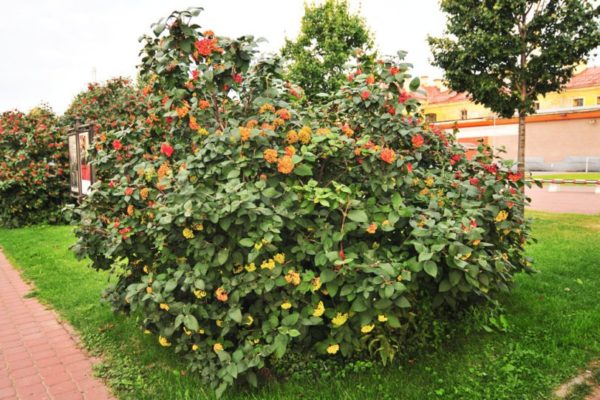
Overgrown viburnum bush, requiring pruning
Kalina: varieties and tips for growing
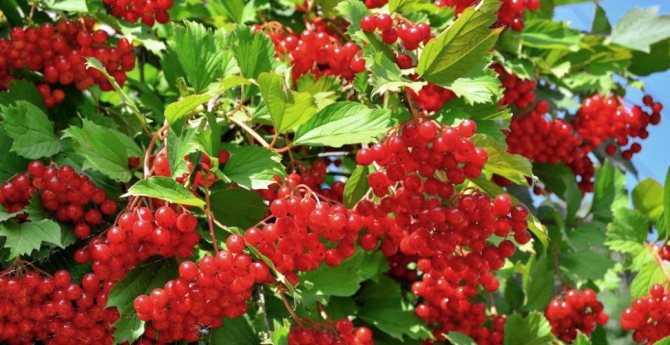

The genus Viburnum itself unites about 170 species - shrubs or small trees. Inhabitant of the temperate zone in the northern hemisphere, but also found in the Andes, in the Antilles, in Madagascar. It is believed that the word "viburnum" comes either from the Proto-Slavic or from the ancient Indian languages. In the first version - the origin from the word kal (wet earth, mud, swamp), because of the moisture-loving viburnum; or from kaliti (to heat, harden), because of the color of the berries. According to one of the legends, viburnum is a girl who loved her homeland, who was killed by her betrothed, who went over to the side of the enemy. White viburnum flowers - innocence, red berries - blood (bitter, like her fate, but giving strength and health to all who love their native land). Indeed, almost all parts of the viburnum are healing: bark, berries, seeds, flowers, and branches.
Healing properties
Everyone knows that the common viburnum is useful, but few people know the entire huge list of its capabilities. Viburnum preparations have excellent tonic, astringent, hemostatic, diuretic and antispasmodic properties. With the help of fruits, they lower blood pressure, strengthen the immune system. A decoction with the addition of honey is used for respiratory diseases. Viburnum juice relieves pain in case of heart and liver problems. Infusions of leaves and flowers (5 and 10%) are a very effective antiseptic. A decoction of the bark is used for convulsions, neuroses and insomnia, and is especially useful for colds.
viburnum - a symbol of the Motherland
About growing viburnum in the garden
Viburnum vulgaris is an unpretentious plant, however, for its successful cultivation, it is advisable to know some tricks. For example, if in nature viburnum most often grows in humid places, then in culture it prefers drier soils with a low groundwater level. Viburnum can be planted both in autumn and spring, preferably in lightened places with a neutral or slightly acidic reaction of the soil, the fertility of which determines the splendor of flowering and fruiting. A month before planting, the soil is fertilized with phosphorus-potassium fertilizers and peat. A group of bushes is placed at a distance of about 3 meters.
Viburnum can be planted both in autumn and spring, preferably in lightened places with a neutral or slightly acidic soil reaction.
With the onset of summer, viburnum will delight you with inflorescences of white or pale pink. With the onset of autumn, its delicate foliage is painted in luxurious shades of yellow, pink, orange and crimson red. Reproduction by seeds. Some experienced gardeners prefer to grow planting material from seed. Seeds are taken from fruitful trees, from the largest and sweetest berries. They can be planted in the fall of the same year, however, such seeds will sprout only at the end of next summer, and will begin to grow actively only in the spring of the second year. For faster germination, stratification is necessary, in which seeds are artificially kept for a long time at a certain low temperature, thereby increasing germination. Propagation by cuttings. Vegetatively, viburnum is propagated by layering or petioles, harvesting them in early July by dividing the bush. For annual shoots, grooves are prepared in the spring, shoots are laid in them, sprinkled with earth and fixed with wire, leaving the top not buried. The above-ground part of the cut is pulled over and cut, and by the autumn they have roots sprouting and shoots appear. The period for harvesting the petioles is June or early July, the length is at least three knots. You can root the petioles not only in the greenhouse, but also at home, in flower pots. In this case, the soil is prepared from humus, sand and sod land in a ratio of 1: 1: 3, and a layer of river sand is poured on top. For a home version, a semblance of a greenhouse is also arranged: the pot is covered with a film or glass jar. When transplanting, the bush is divided into several parts, on each of which three or four renewal buds must be preserved. Transplanting works are performed in spring and autumn. The seedlings obtained by vegetative propagation begin to bear fruit after a year.
Care Tips
Watering. During the dry period, the viburnum needs watering. Young seedlings are watered in the evening, soaking the soil with water to a depth of 40 cm. Watering of adult bushes is given special attention during the growing season and ripening of berries. Fertilizers. Before blooming the leaves, the viburnum is fertilized with urea. Before flowering - potassium sulphide or wood ash. In the middle of summer, complex fertilizers are applied, every 2 years, when digging the soil around the bush, phosphorus-potassium fertilizers and rotted manure are applied. Forming. Pruning is recommended in spring, rejuvenating - 6 years after planting, leaving up to 15 main branches. In the case of a weak or almost non-flowering bush, pruning to a height of about 20 cm from the ground saves. For lush, beautiful flowering, shoots longer than 40 cm are pinched by hand. For a year, viburnum shoots can grow up to 40 cm. The crown must be formed by removing unnecessary and diseased branches.
Viburnum varieties in ornamental gardening
Kalina Roseum (Roseum, Buldenezh, Snow Globe). Everyone is familiar, with increased decorative qualities, a variety that does not form berries, with inflorescences-balls hanging at the ends of branches and changing color during flowering: from green to white, and then to pinkish. Kalina Nanum (Nanum). A dwarf decorative form up to 1 m high with small openwork leaves. Young leaves of viburnum Nanum have a reddish tint. Kalina Aureum (Aureum). Plant with unusual golden foliage and deep red fruits, 1–2 m tall.
History and description of the tree
Kalina is a tree with which many legends and fairy tales are associated. Our ancestors decorated wedding feasts with viburnum, providing a young family with happiness and procreation. On weekdays, clusters of viburnum were laid out in the house, protecting it from evil spirits, damage and curses. The berries of this plant were depicted on towels, women's clothing and even on the shutters of houses. The culture is especially popular among residents of the southern regions.
Today there are at least 150 species of this tree.They all have their own characteristics. "Snow Globe" or "Bul-de-Nezh" boasts beautiful round inflorescences, "Compactum" - a dense crown, and "Xanthocarpum" - yellow berries. But the most common tree is the common viburnum, familiar to us from childhood.


Viburnum is a small decorative tree. Some even consider it a shrub. Its trunk is thin and branched. The leaves are large, the inflorescences are white, sometimes they can have a slight pinkish tint. Viburnum begins to bloom in mid-May and continues to bloom for a month and a half. The fruits of the viburnum are blood-red in color with a small stone inside. They ripen by autumn, and they can hang on a tree until winter. A mild frost will even improve their taste and health benefits.
16 excellent varieties of plums for the Moscow region
TOP popular varieties
One of the advantages is a huge list of different types of viburnum. Both deciduous and evergreen shrubs or trees are cultivated. Farmers grow both remontant and non-fruiting varieties of this plant, which differ in a variety of shapes and sizes. There are even subspecies blooming in winter - these are Forreri and Bodnantenskaya viburnum.
The most popular are the following varieties of red viburnum:
- From medium-sized: Zholobovskaya, viburnum Red coral, Red bunch, Leningradskaya elite.
- From vigorous: Roseum, Maria, Ulgen, Shukshinskaya, Dachnaya.
- From undersized: Eskimo, common viburnum Nanum and viburnum Compactum, as well as Nana dwarf.
In regions with severe weather, the viburnum of the Shukshinskaya variety, as well as Zarnitsa, Zakat, Maria, Ryabinushka, Vigorovskaya, will take root best of all.
For areas with a temperate climate (for example, the Moscow region), Souzga, Ulgen, Zholobovskaya, the variety of viburnum Taiga rubies are suitable.
Gardens in warm areas will be decorated with Aurora, Elixir, Garnet Bracelet, Red Bunch.
A separate place is occupied by sweet-fruited varieties of viburnum, which are distinguished by the sweetish taste of berries without bitterness: Vigoroskaya, Souzga, Shukshinskaya, Bureinskaya, Leningradskaya Otbornaya.
Viburnum in garden landscaping (with photo)
All varieties of viburnum are quite decorative, they are appropriate in all kinds of planting variations. For this reason, viburnum is used quite often and successfully in landscape design. It is important that the compulsory care for the viburnum is not fraught with any difficulties. Thanks to the powerful root apparatus, viburnum bushes reliably strengthen the slopes, steep slopes.
Viburnum looks advantageous in tandem with maples, lindens, birches, spruces, mountain ash. Its miniature form is also cultivated - a spherical, elegant dwarf bush, the diameter of which rarely exceeds 1 m. Such voluminous "caps" of dark green color are very interestingly located on lawns along with garden forms of conifers. Before trimming the viburnum, it is recommended to imagine how harmoniously the planned composition will fit into a particular space.
To understand what the options for using viburnum in landscape design may be, see the photo:
If you are tired of the newfangled capricious plants used in the design of plots, then the viburnum will be the best choice for your yard (how to plant and care for it is described in detail above). Gardeners appreciate for its unpretentiousness, attractive appearance. This shrub responds with great sensitivity to the most elementary care, in gratitude for the care it pleases with spectacular flowering, autumn foliage triumph. Viburnum is a charming and very useful plant.
Many people immediately associate the word “viburnum” with the definition “red”. But in our time, viburnum has so many varieties that the color of the berries can even be black. Kalina is loved by many for its beauty both in spring and autumn.
Viburnum (Viburnum)
At the beginning of summer, she pleases us with beautiful umbrella or spherical inflorescences about 15 cm in diameter with snow-white or pale pink flowers.And in the fall, the carved foliage of the viburnum becomes especially beautiful, glowing with numerous shades of orange and crimson-red with scarlet berries hanging from the branches.
Unusual and original varieties
An unusual type of plant is gaining more and more popularity.
Gordovina, or black
Differs in a compact crown and tall, reaches 5 m in height. Wrinkle-leaved viburnum with juicy green leaves in the upper part of the crown and slightly silvery at the bottom.
Note! At the beginning of fruiting, the bunches, in addition to black, have rounded berries and red, which acquire a black color by the beginning of autumn.
Toothed
A tall shrub with a dense crown grows up to 5 m. Features of the variety: viburnum has blue berries and serrated foliage with obvious deep cuts.
Canadian
The tree is quite high for a viburnum in size: up to 6 m. The crown is spherical, resembling the shape of an egg. The foliage is wide, glossy, with pointed ends in a bright green hue, which, with the arrival of autumn, is replete with all shades of red and burgundy. It blooms with pale white small flowers, collected in inflorescences. Fruits are dark blue in color.
Viburnum grade Mayskaya sweet
Forked
The foliage changes color depending on the season: in the spring - red-brown, in the summer - green, in the fall - an almost poisonous lilac shade. Parallel veins with branches form a fancy pattern. The fruits are red.
Wrinkled
The variety belongs to evergreen shrubs, has strongly pubescent branches. It grows up to 3 m. Leaves are glossy on top, with a downy fluff. It blooms in gray with yellow color. The berries are oblong oval, red in color.
Kalina varieties Sargent
A four-meter sprawling bush with maple-like leaves and white inflorescences.
Interesting! It is a rare viburnum with yellow fruits.
Folded viburnum
The bush is up to 3 m high. Wide velvet leaves of rich green color frame white creamy inflorescences. From this variety, a subspecies of Pinkbeauty is obtained, the flowers of which are characterized by a color change from white to pink during the flowering process.
Viburnum laurel variety
An evergreen bush with a dense crown of three meters in height. The foliage is bright green above, white discolored fluffy below. The inflorescences include fragrant pink-white flowers, fruiting with dark blue, blue-black berries. Has variegated varieties.
David's variety
Dwarf shrub up to 1 m in height. Differs in slow growth and horizontal growth of branches.
On a note! It bears fruit with blue berries.
Buldenezh
Snow-white large spherical inflorescences of viburnum are the visiting card of the variety. Does not bear fruit. Reaches a height of 3.5 m.
Blue Muffin
Perennial toothed subspecies of viburnum, blooming in summer with white inflorescences with a pleasant smell, fruiting in autumn with blue berries in brushes.
Benefits of autumn planting and transplanting in open ground
It is known that viburnum can be planted both in spring (late April - early May) and in autumn (September). According to experienced gardeners, planting a plant in the fall has some advantages:
- planting is best done in early September, so that the seedlings have time to take root;
- in the fall, the soil around the plant will settle, become dense;
- there is no intense heat in the autumn period, therefore, there is no need for frequent watering;
- a seedling planted in the fall, vegetates in the spring, as the roots develop, and the bud is sleeping at this time, thanks to this, young shoots develop more actively;
- in the spring there are many things to do in the garden and garden, so in the fall, when there is more free time, you can start planting viburnum.
Breeding specifics
Even if viburnum varieties do not require special care, some features should still be taken into account.
Garden viburnum, like most types of shrubs, is planted in open soil on the site in spring, after warming up the earth, or in the fall, before the onset of cold weather.
Viburnum fruit Taiga Ruby
Edible viburnum leaves hatch relatively late. Seedlings with open roots are preferably planted in April and May days, they will have time to start before the buds swell. In addition, they will feed on moisture remaining in the ground from melting snow.
Note! A tree with a closed root system (in a container or a sturdy bag) has no time limit for planting.
Description of the benefits of closed roots:
- Works can be carried out in spring, summer and autumn - from September to November.
- When planting in the chosen place, there is no possibility of damage to the root system, since it is protected from the outside.
- Such seedlings, when properly planted, have a shortened acclimatization period and a high survival rate.
Suitable soil, watering and fertilizing
Shrubs can take root in any soil, which is why wild viburnum is so common. But it is desirable that the substrate is light, fertile.
Despite the fact that viburnum loves moisture, water stagnation is contraindicated for it, therefore, when planting, drainage must be done in the hole. It is worth choosing a sunny place, but in a small shade the bush will develop rapidly.
Advice! Watering is best done in the evening. You need up to 40 liters of water per square meter. This is especially true for the period of flowering, fruiting and drought.
Fertilize 4 times from spring to winter. For the first time - when throwing out foliage, the second and third times - before and during flowering, the last - before wintering.
Pruning
Without pruning, the number of shoots will increase rapidly, they will all tend upward towards the sun, and soon the shrub will turn into an unkempt clump of tangled branches.
Pruning is a very important part of crop maintenance. Depending on the need, perform:
- sanitary;
- thinning out;
- formative trim.
In the first method, diseased, dried, frozen shoots are removed, in the second case, they get rid of excess, densely growing and irregular branches that interfere with the development of the plant. The last type of pruning is carried out in order to give the culture an aesthetic appearance by forming a crown.
Sanitary pruning is carried out at any time of the year, thinning - from mid-spring and during the summer, shaping - in early spring, 2-3 times in summer, in late autumn.
Pests
Periodically, viburnum can be overcome by pests that adversely affect the plant and negatively affect the quality and quantity of the crop.
The tree is attacked:
When fighting these insects, you need to shake them off the shoots every morning on a film spread under the crown. Then get rid of them.
Purchased complex action products cope with unwanted "guests" perfectly: fufanon, lightning, kinmix, karbofos, fitoverm, green soap.
Diseases
Viburnum viburnum is susceptible to the following diseases: powdery mildew, gray and fruit rot, yellowing, mosaicism and leaf spot can also be observed.
Note! Struggling with an ailment, you need to find out the cause of its appearance, purchasing drugs for treatment, focus on a specific type of disease.
Reproduction and rooting
Viburnum can be propagated in different ways: by cuttings or seeds. The second method is very long and can take more than 2 years. Vegetative propagation can be carried out in several ways: by basal processes, vertical or horizontal layers. Vertical layering is the simplest method that does not require much work.
- Seeds. They are placed in wet sawdust, tightly packed in nylon stockings. So they are stored for 2 months at room temperature until they begin to germinate. Sprouted seeds are placed on the bottom shelf of the refrigerator for another month. After 30 days, the seeds are sown in a small box filled with soil. If the sprouts have gained strength over the winter and look healthy, in the spring they are planted in the garden, watering abundantly. If they are still weak, they should be left in the drawer for another year. But for the summer to take out the box in the sun.
- Cuttings. Cuttings for planting are harvested during the flowering of the tree.They should be springy but not brittle. Cut green cuttings - 10-12 cm with 2-3 nodes. In winter, they are kept under a dome or in a greenhouse in a special soil. And in the spring they are planted in the garden.
- Vertical layering. In autumn, the lower branches of a young plant are shortened, leaving 2-4 buds. They huddle the trunk, covering these buds with soil. By the spring, they will give shoots, which are again covered with earth until they reach 30 cm. After that, they are dug up, pruned and covered with soil again. In autumn, the shoots are separated from the tree and planted on their own.
- Horizontal layering. A two-year-old branch is pruned, leaving an appendix with 2-3 buds. When it sprouts in the spring, it is again shortened by 1/5 part, bent to the ground and lowered into the prepared hole. This is left until shoots appear. By autumn, the mother branch is removed, the shoots are separated and planted separately.
Interesting features of viburnum
- Almost all the fruits of viburnum varieties are edible, tart to the taste, mostly bitter, but there are also sweet ones.
- The viburnum harvest has beneficial properties: it is rich in phosphorus, potassium, magnesium, iron, copper, manganese, iodine, vitamins A and C.
- Berries have a lot of applications: they make jams, bake pies, use them to make tea, treat themselves, make all kinds of cosmetic masks and scrubs, make alcoholic beverages.
- Almost all the components of viburnum (bark, leaves, flowers, berries) are used for medicinal purposes.
- The shape of the crown can be easily changed, since these shrubs tolerate pruning well.
- Plant varieties are often used for the benefit of humans: they are planted along roads to create snow-collecting areas; for strengthening the soil in mountain areas; to attract birds to forests, planting different species of viburnum in plantings; and also planted in public places (often it is a viburnum of the Sargent Onondaga variety).
Having decided to decorate your garden with viburnum shrubs, you can get lost in the variety of varieties. Which variety to choose: dwarf or tall, with ordinary red fruits or with a more original color, with a round crown or a more spreading version? But even having opted for the first variety that comes across, it will be possible to settle an excellent decorative ornament on your site, which also has a lot of useful properties and does not require significant efforts during cultivation.
Features of planting and care
- The soil. Kalina is undemanding to soil indicators, although it feels better in slightly acidic or neutral soil. Viburnum will also be accepted on poor soil, but it will bear little fruit. Even close ground waters are suitable for her, because this tree loves moisture.
Advice. If the garden has a small pond or river at the end of the site, then the shore of the reservoir will be the best place for viburnum.
- Landing. In warm regions, viburnum can be planted in the fall. But it's better to do it all the same in the spring. A pit is dug 50x50 cm. The dug soil is mixed with peat, compost, potash, nitrogen and phosphorus fertilizers. Immerse the seedling 3-5 cm.
- Watering. Since viburnum is very fond of moisture, this plant will have to be watered often. To keep moisture near the root longer, the trunk must be mulched with sawdust or compost.
- Fertilizer. In order for the viburnum to bloom magnificently and bear fruit, it must be enriched twice a year with complex fertilizers. And in August, you need to add phosphorus and potassium.
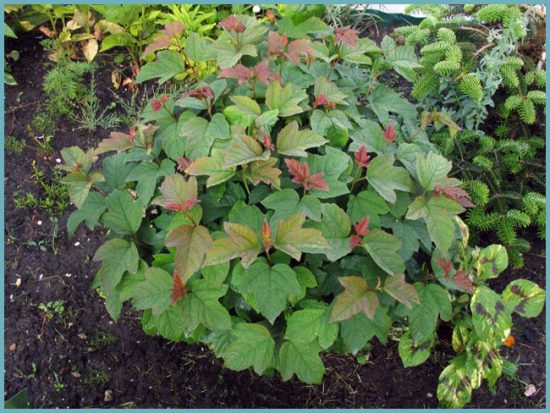

Scientists have developed several varieties of viburnum without bitterness
In Russian folklore, as you know, two berries are mentioned more often than others. Raspberries represent a sweet, happy life. And viburnum is a bitter fate. This comparison is based on the taste of the fruit. But scientists decided to break stereotypes and bred several varieties of viburnum that have no bitterness.
More precisely, there is almost no bitterness, because no one has yet been able to get 100% sweet viburnum. But compared to wild ancestors, the fruits of some varieties have a barely noticeable bitterness. True, the tasters are cautious, although they give a high score for the viburnum - 4 points (out of 5 possible), but the taste is called slightly bitter.Meanwhile, some berries contain quite a lot of sugar.
This is the sweetest variety of viburnum - 14% sugar in berries. And his score is more than high - 4.2 points. Because everything is in moderation here: a little sourness, a little bitterness, as a result, a completely balanced pleasant taste is obtained.
Fruits and Vigorovskaya are bright red, weighing 0.5-1.5 g. Productivity 6-10 kg per bush.
The plant itself is of medium height - up to 3 meters. Looks very elegant in autumn, when the leaves become brightly colored.
Unfortunately, reference books do not indicate the amount of sugar in the fruits of this variety. But tasters rate the taste as “sweetish-sour, with a slight astringency, almost no bitterness” and boldly give 4.2 points, adding that the berries are also very aromatic.
Mary's fruits are light red, weighing about 0.6 g. An average of 8 kg can be harvested from one plant.
The bush grows up to 5 m. It does not get sick and is almost not affected by pests. Looks very impressive in the fall, when the leaves turn crimson-golden.
By the amount of sugar it takes the second place - it is 13% in fruits. Experts rate the taste at 4 points, marked "sweetish, slightly bitter."
Ulgen's fruits are medium-sized, about 0.7 g, but they are collected in very large spectacular brushes - 35-50 pieces each! And they also contain a lot of vitamin C - 130 mg (in wild viburnum about 50 mg). Productivity 9-11 kg per bush.
The plant is quite tall - up to 4 m, and sometimes even taller. Loves watering. The variety is resistant to diseases and aphids.
V
"Ulgen" in translation from Altai means "good spirit".
Here, too, the question arises with the amount of sugar in the fruits, but we will believe the tasters. And they write that the taste of this variety is “sweet and sour, with a little pleasant bitterness,” and give a solid four.
The fruits of the Red cluster are bright red, weighing 0.75 g. Low yield - 2.5-4 kg per bush. But the berries are very healing - they contain vitamin C as much as 140 mg! This is the highest among sweet viburnum.
The bush grows compact, no higher than 3 m, does not get sick, is not affected by pests. In the fall, it glows in the garden with a crimson-scarlet dress of leaves.
In the berries of this type of sugar 11.8%. Taste - 4 points, "slightly bitter, almost sweet."
The fruits, unlike most other varieties, are not round, but oval, weighing 0.6 g. Productivity - 6 kg per bush.
Zholobovskaya is ideal for small gardens, since the bushes of this variety are very compact and low - no more than 2 m.
Almost all of the listed viburnum varieties require pollinators. And in order to get a good harvest of useful berries every year, 2-3 different varieties must be planted on the site.
And the yield of viburnum is highly dependent on the weather and care. This culture bears fruit abundantly only in sunny areas, with regular watering and feeding.
TRICKY QUESTION
Oleg Smirnov, Samara: “I've heard that bitter viburnum is much healthier than sweet one. Is it so?"
Partly yes. The bitterness of viburnum berries is given by iridoids - biologically active substances that increase appetite and improve digestion. In addition, they kill harmful microbes in the body.
But then another problem arises: you can't take such a viburnum in your mouth. And there are hardly many extreme sportsmen who, for the sake of benefit, will chew bitter berries. And so that the fruits become edible, many summer residents freeze them. But after that, valuable iridoids disappear, and with them also vitamin C.
There is much less useful bitterness in the berries of sweet viburnum, but it is there. This means that there will be benefits from it. Moreover, berries can be safely eaten fresh. As a result, it turns out that sweet varieties provide more benefits to the body than bitter ones.
Disease and pest control
There are not many diseases and pests that can affect viburnum. Nevertheless, every gardener needs to be ready for them.
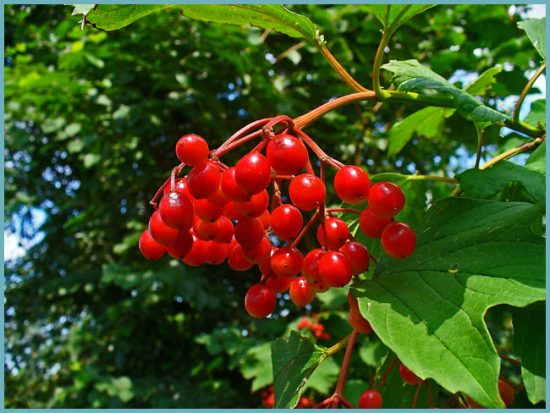

- Powdery mildew is a fungus that manifests itself as a powdery bloom on the leaves. They turn brown from this. Because of this disease, viburnum ceases to bear fruit.They fight powdery mildew with a solution of potash sulfur and various fungicides.
- Frostburn - a consequence of low temperatures, manifests itself in cracked bark and "bare" wood. These "wounds" are watered with liquid clay in the spring. If the branch is severely affected, it is removed.
- Ascochitous spotting of viburnum appears as gray spots with a brown border on the leaves. Fungus grows in these spots. Therefore, in the fall, the affected leaves are burned. And in the spring, a sick tree is treated with Bordeaux liquid and copper oxychloride.
- Viburnum leafworm is an olive-colored caterpillar. She eats the buds and leaves of the tree. Before that, the insect envelops them in cobwebs and rolls them into a tube. If left unchecked, it will severely damage the tree. Therefore, caterpillar nests must be removed and burned. Also, the tree is treated with the drug "Nitrafen".
Viburnum is also threatened by gray and fruit rot, leaf beetle, leaf aphid, honeysuckle gall midge and lobed moth.
In addition to the beauty of the tree itself, viburnum gives the gardener a rich harvest of useful berries. This is a real treasure for traditional medicine recipes. They will cope with colds, sore throats, diseases of the heart, blood vessels and skin, overwork and many other problems. Therefore, viburnum is a must have for every personal plot.
Flower bed design. TOP 10 simple and effective techniques
KALINA
Vigorovskaya
Ripening in early September. Resistant to diseases and pests, frost-resistant. Shrub with 3-5 skeletal axes, up to 3 m high.
Berries up to 9.5 mm in diameter, weighing 0.5 g, spherical, juicy. They contain: sugar 14%, acid 1.6%, vitamin C - 46 mg%. Tasting score 4.2 points. Differs in high dietary and medicinal properties of berries.
Productivity 52 kg / ha.
GNU Research Institute of Horticulture of Siberia named after M.A. Lisavenko.
Garnet bracelet
Medium-late ripening. The variety is resistant to low temperatures, diseases and pests. The bush is medium-sized, medium-spreading.
The berries are large, weight 0.8 g oval, slightly elongated at the top, dark red. They contain: sugar 10.4%, acid 1.9%, vitamin C 31.2 mg%. The taste is sweet and sour with a pleasant bitterness. Tasting score 4.3 points.
Productivity 120 kg / ha. Suitable for all types of processing and fresh consumption.
GNU All-Russian Research Institute of Horticulture. I.V. Michurin.
Zholobovskaya
Ripens on September 14-15. Winter hardiness is high. The variety is resistant to disease. The bush is compact, begins to bear fruit in the 5th year.
Berries weighing 0.57 g. The pulp is juicy, slightly bitter, almost sweet. Tasting score 4 points. They contain (%): dry matter - 18.5, sugars - 11.8, acids - 1.7; vitamin C - 116.0 mg%, vitamin P 720 mg%.
Self-infertile. Average yield - 25.0 kg / ha, maximum - 53.3 kg / ha (5 to 10 kg per tree). General purpose, small seeds. Needs irrigation or soils provided with natural moisture.
GNU Research Institute of Horticulture of Siberia named after M.A. Lisavenko.
Zarnitsa
Medium ripening. Highly winter-resistant. A tree with 5 skeletal branches.
Berries weighing 0.6 g, ellipsoidally pointed, light red, bitter. They contain: sugar 7.7%, vitamin C 111 mg%. Tasting assessment of berries 3.7 points.
Productivity 46.6 kg / ha (6-11 kg per bush).
For industrial processing of the State Scientific Research Institute of Horticulture of Siberia named after V.I. M.A. Lisavenko.
Red bunch
Medium ripening. Winter hardiness is high. Resistant to pest diseases. The bush is medium-sized, medium-spreading. Shoots are straight, light green.
Berries weighing 0.74 g, round, dark red. The taste is sweet and sour, with reduced bitterness.
The variety is self-fertile, the yield is high, 10–12 kg per bush. Propagated by green cuttings and layering.
GNU All-Russian Research Institute of Genetics and Selection of Fruit Plants. I.V. Michurin.
Souzga
Ripens on September 20-30, high winter hardiness. Disease resistant. The bush is compact, begins to bear fruit in the 5th year.
Berries weighing 0.65 g, spherical, crimson-red. The pulp is juicy, slightly bitter. Tasting score 3.8 points.The berries contain (%): sugars - 10.1, acids - 2.0; vitamin C - 138.0 mg%, vitamin P - 585.0 mg%.
Self-infertile. The yield is high, 50 c / ha, maximum - 83.3 c / ha. (about 5–12 kg per tree). Needs irrigation or soils provided with natural moisture.
GNU Research Institute of Horticulture of Siberia named after M.A. Lisavenko.
Taiga rubies
Ripens in the second decade of September. High winter hardiness, disease resistant. The bush is up to 3 m high with a crown diameter of 2–2.5 m.
The berries are globular, dark red, 9.5 mm in diameter, weighing 0.5 g. The taste is slightly bitter with a sweet taste. Tasting score 3.5 points. They contain: sugar 9.6%, acid 1.6%, vitamins: C - 133 mg%, P - 670 mg%.
Productivity 22.4 kg / ha. The variety is self-fertile, propagated by green cuttings.
Care: how to plant and prune bushes?
You need to take care of the viburnum as well as for other cultivated plants: weed control, regular watering, loosening the soil in the near-trunk circle, mulching, cutting and forming the crown, fighting diseases and pests.


Spring flowering viburnum
Watering
Watering is carried out in the evening, shedding the soil by 40 cm. Adult bushes should be watered during the growing season and when the berries are ripe.
Top dressing
Usually, dressings are made dry, in hot dry weather it is better to dissolve them in water. You need to feed the plant several times:
- In early spring, when young leaves bloom. Urea is introduced (2 tbsp. L.);
- Fertilizer is applied just before flowering. Wood ash (1/2 liter) or potassium sulfate (2 tablespoons) should be scattered;
- Feeding is carried out after flowering. Nitrophoska or nitroammofoska is introduced (2 tbsp. L.).
- Liquid dressing is applied in October, when the crop has already been harvested. Potassium sulfate (2 tablespoons) and superphosphate (3 tablespoons) are added to ten liters of water. Each viburnum bush requires two buckets of fertilizer
Viburnum varieties: features of the best species


Kalina, in spite of its specific bitter taste, began to grow precisely for the harvest. Not for her "slender waist" or "majestic crown", as we used to hear in various works of art. Although, in landscape design, it is often used. Interestingly, she does an excellent job with this task. From one grown bush, you can get 8-10 kg of harvest.
Using the fruits of viburnum, you can lower blood pressure, as well as reduce pain in the presence of heart and liver diseases. Infusion from its leaves and flowers will give you an excellent antiseptic as a result. Convulsions, neuroses and insomnia are easily fed to a decoction of viburnum bark. It is also used for colds.
With regard to its cultivation, the viburnum is one of the few plants that can germinate in completely different climatic conditions. There are varieties that are more suitable for the northern regions, because they easily endure winter. Also varieties that bear fruit especially plentifully, being grown in the center, since in this region the summer is longer. And those varieties that will delight with beautiful fruits only in the south, easily overcoming even the longest drought. Kalina can be grown anywhere. Having previously selected the right variety for the climate of your region. The root system of the viburnum is so "neat" that it can be planted under the window. The best neighbors for her are maple and pine.
Formation
Unlike other fruit shrubs, viburnum does not require frequent pruning of shoots. Shoots are usually removed once a year.
When a plant is formed by a bush, in the spring all branches are removed by 2-3 nodes. Growth points are pinched when they reach a length of 30 cm. Awakened buds will give young shoots. They will be the main component of the plant. IN in subsequent years, systematic pruning of the viburnum will form the desired size of the bush.
If you want to see the viburnum as a tree, at the beginning of the formation you need to leave the vertical central trunk. The rest of the side branches should be removed. The shoots around the bush are also cut off.After 2-3 years, a trunk with a height of about two meters will form. The crown is formed by pinching the growth point. The tip of the guidewire is cut off and several buds appear at the cut site. Thanks to this procedure, the tree becomes branched.
It is not difficult to grow viburnum on your own site. You need to be able to competently take care of her. Then the plant will delight you with magnificent flowers and beautiful healthy berries.
Using
Viburnum is very decorative... Most of them bloom in late May and early June, completing the spring riot of colors with their white, pinkish or yellowish inflorescences. Flowering is long, sometimes stretching for two or three weeks. Some species (viburnum vulgaris, forked, Sargent, three-lobed) have very large, up to 12-15 cm in diameter, umbellate inflorescences, consisting of two types of flowers. In there are small tubular fruiting flowers, which subsequently give berries. And along the edge there are large and brighter sterile ones, the main task of which is to attract pollinating insects. In other species (viburnum, Bureinskaya, toothed, Mongolian, Gordovina, Canadian Gordovina, Wright, Slate), inflorescences are formed only by fertile flowers, but their size, brightness and delicate aroma are also impressive. All viburnums are good honey plants.
Viburnums are also beautiful with their leaves. In common viburnum, three-bladed and Sargent, they are lobed, consisting of 3 or 5 lobes (in shape they are somewhat reminiscent of the leaves of the Norway maple). The viburnum of Bureya, forked, toothed, Mongolian, Wright, sycamore and both horodovins have leaves of an oval or elliptical shape that is unusual for us. Summer color - from light green to deep dark green, but in autumn all viburnums are colored in the brightest tones of the warm part of the spectrum - from yellow to carmine red. The great poet was accurate, comparing a viburnum bush with a burning fire. Against the background of such a fire, it is sometimes difficult to see the berries. The most unusual leaves are forked viburnum: large, up to 25 cm long, rounded-ovate leaf blades are cut with a whimsical net of relief wrinkles. In autumn, they are painted with several colors at once - on one sheet you can simultaneously see green, yellow, scarlet, crimson, red-brown and purple spots.
Viburnums are also famous for their fruits. Berries in most species acquire color in August.... They look contrasting against the background of a dense crown, delight the eye throughout the fall and decorate the bushes even in winter. In some species, the fruits are red or pinkish-orange, when ripe, juicy, like in the common viburnum. Other species produce black berries with a bluish or blue bloom. But there are also such viburnums that have fruits of two colors in the brush: some of them, mature, are black and shiny, others, immature, red. This contrast is especially beautiful and attractive. It is characteristic of the gordovina viburnum and the forked viburnum.
There is conflicting information about the edible properties of viburnum fruits: someone reports their exceptional value, and someone writes about their toxic properties. This is true and not true. The fruits of almost all types of viburnum are edible (whether you like their taste or not is another question), but you should only eat fully ripe berries and know when to stop... Otherwise, vomiting and diarrhea are possible. The edibility of the fruits of the viburnum ordinary, Sargent, three-lobed is reliably known. Their juicy red berries lose their tart bitterness after freezing, as well as when processed into jelly, jam, mashed potatoes, and dried berries. Their fruits are not only tasty, but also have healing properties: they normalize blood pressure and improve digestion. Popularly, the fruits of the common viburnum are used as a vitamin, tonic, diaphoretic and diuretic, as well as a mild laxative.... Among the viburnum with red fruits, the three-lobed viburnum is considered the most pleasant to taste and therefore in its homeland, in North America, is called "cranberry" viburnum.The berries of black-fruited viburnum (burein, lily, canadian gordovina) are also edible, have a sweetish and somewhat mealy pulp.
Some species of viburnum are known for very beautiful decorative forms that differ from their wild ancestors in unusual features of their external appearance.... The most famous garden cultivar of the common viburnum is Buldenezh (Boule de Neige, or Sterile, Roseum). The name of this variety is translated into Russian from French as Snow Globe, or Snowball (although it would be easier and more understandable to call it “snowball”), because its main feature is large, up to 10 cm in diameter, globular inflorescences of snow-white color consisting only of sterile flowers. Such bushes do not bear fruit, but the abundance of "snowballs" hanging all over the bush at the end of May is always surprising. The common viburnum also has the Compactum form. This plant is rather modest in size, up to 1.5 m in height and in diameter, but in flowering and fruiting this variety is not inferior to wild viburnum. There is also a real dwarf form - a dense spherical bush, rarely exceeding 1 m in diameter... Funny "balls" of dark green color look very interesting on the lawn along with garden forms of conifers, but rarely bloom and bear fruit. In viburnum, gordovina are best known in the cultivar culture Variegatum and Aureum. The first form is remarkable for the marbled pattern of yellow and light green spots on the wrinkled leaves, in the second cultivar the foliage is greenish yellow.
There are also a number of species of viburnum, the cultivation of which in central Russia would be very interesting, if not for the weak winter hardiness. This is Karls' viburnum (V. carlesii), because evergreen (V. tinus), because wrinkled (V. rhytidophyllum), because David (V. davidii), because fragrant (V. odoratissimum), because fragrant (V . farreri), because Japanese (V. japonicum), as well as a number of hybrids (V. x. burkwoodii, V. x. bodnantense, V. x. caricephalum). They are beautiful and unusual, many are evergreens, have a strong and pleasant scent of flowers. Some of these species can withstand clipping in classic green hedges. In our harsh climate, sometimes, with very painstaking care and careful shelter of plants for the winter, it is possible to keep them alive. But in this case, you will have to forget about flowering and even more so a haircut. These types of viburnum are suitable for the south and extreme south of Russia.
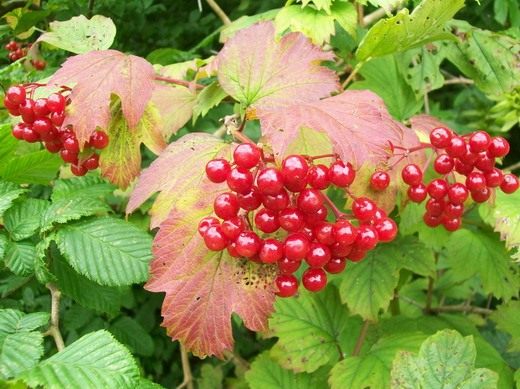

<>
Contraindications to the use of red viburnum
The use of red viburnum is contraindicated for people with increased blood clotting and prone to the formation of blood clots. Its use is contraindicated in hypotensive patients - people with low blood pressure. Use is contraindicated in case of increased acidity of gastric juice. Do not use it during pregnancy and breastfeeding.
Before use, a consultation with a doctor is required !!!
If you have experience in using this plant, please do not be lazy and leave a comment on the article !!!
Healing properties
Buldenezh - shrub for the garden kalina buldenezh
Ripe fruits are harvested and dried, after which they are used for medicinal purposes. Kalina is the record holder for the amount of all kinds of vitamins and microelements (per 100 g of berries):
- ascorbic acid - up to 80-135 mg;
- nicotinic acid - up to 1350 mg;
- carotene - 2.5 mg;
- vitamin K - up to 30 mg;
- folic acid - up to 0.03 mg;
- molybdenum - 240 mg;
- selenium - 10 mg;
- manganese - 6 mg;
- iron - 0.3 mg.
Note! Viburnum is an excellent honey plant, producing up to 15 kg of nectar from 1 hectare of solid planting.
The fruits are recommended for people suffering from metabolic disorders, with pathologies of the cardiovascular system and the digestive tract. The child can drink decoctions and various culinary products with viburnum without restrictions.


